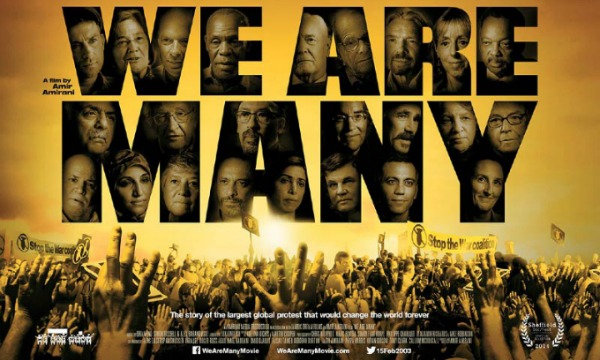 An impressive collection of contributors, ranging from Tony Benn to Brian Eno, discuss the impact that the 2003 anti-war marches had upon the decision to go to war, how they shaped public thinking, and the legacy the protests left behind.
An impressive collection of contributors, ranging from Tony Benn to Brian Eno, discuss the impact that the 2003 anti-war marches had upon the decision to go to war, how they shaped public thinking, and the legacy the protests left behind.
Make no mistake, this film is not simply another anti-Bush and Blair piece, the likes of which we have seen so many times before. As would be expected the film is set against these figures, and although it inevitably spends a fair amount of time talking about them and the governments that they represent, WE ARE MANY sets out with a much wider and further reaching gaze, investigating exactly what it took to organise such an unprecedented display of protest, what a mass demonstration did mean and can mean in the future on a global scale, and just what level of power ‘the people’ hold in today’s democracy.
A large part of the film’s initial power comes from the audience’s knowledge that the people we are watching discuss the early stages of mobilising the antiwar protest are ultimately going to fail in their goal. As the discussions cover the preparations made all the way up to the day of the march, the audience’s sense of indignation inevitably rises. The staggering footage of between fifteen to thirty million people (estimates vary) marching around the globe against military action in Iraq is deeply affecting, both as a display of humanity and due to the knowledge that they will ultimately be ignored.
One of the film’s biggest strengths is how passionately it fights for its cause, using everything from video testimonials to intelligent editing. The simple, but eloquent power of juxtaposing images and sound is made full use of here – particularly during a government video of Bush comedically looking under furniture for the elusive WMDs, then contrasted against stills of suffering Iraqis. The laughter of Bush’s crowd haunts the images, disturbing the humanitarian rhetoric of the governments who sent us to war, and illustrating the government’s misrepresentation of truth and of the consequence, which WE ARE MANY talks about in depth.
This lack of detailed discussion is the film’s biggest flaw.
When a film criticises a government for not listening to loud opposing voices, it unwittingly turns the gaze upon itself – and here there is a distinct lack of discussion from the other side. WE ARE MANY does inform us that Blair and others were contacted, but they almost unanimously refused to participate. Those few we do hear from are perhaps not asked quite the right question in order to get the debate started. As individual viewers, we must ask ourselves how valuable a document this film is when it displays such a clear bias. The focus on those who were involved in the march does alleviate a certain pressure, providing a more complete portrait. However, a little more realisation of its subjectivity couldn’t hurt. Wouldn’t it be a more complete picture if those who opposed the march, and who dispute the claim that it influenced events in Egypt and the discussion regarding Syria were given a voice?
It is easy in the year 2014 to portray Bush and Blair as villains without meeting much opposition. The film enters more daring territory when it claims the uprising in Egypt found inspiration in the antiwar movement in 2003, and that the protest’s legacy directly influenced political decisions regarding military action in Syria. These are big and, unfortunately, not fully developed claims – extremely interesting to think about, but not expanded upon enough in the film. This lack of detailed discussion is the film’s biggest flaw. Hopefully those who come away from the film intrigued will start researching the claimed connections themselves, and reappraise just how much power a protest could end up having. WE ARE MANY is essential viewing for anyone who believes that the 2003 protests came to nothing, and who have consequently given up on politics, on people power. With open eyes, watch this film and judge for yourselves what difference, if any, the protest made.
httpvh://youtu.be/0mr1aZewfI8

